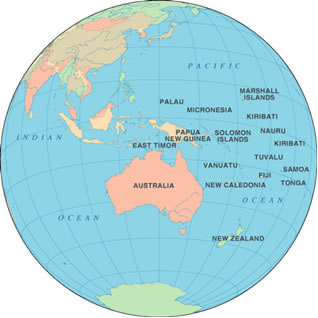Aspectos naturais da oceania
- Comentários desativados em Aspectos naturais da oceania
Características gerais da oceania: A Oceania é o menor continente do planeta, sendo cortada pela Linha do Equador, pelos Trópicos de Câncer e Capricórnio, além da Linha Internacional de Data (LID). Possui 14 países independentes, várias colônias e possessões de terra. É banhado pelos Oceanos Índico e Pacífico (ocidente e oriente na ordem). Por ter sido o último continente colonizado pelos europeus, a Oceania foi chamada de “Novíssimo Mundo”. Seus principais países são: Austrália e Nova Zelândia (os que mais possuem destaque no cenário internacional.) Sua geologia é bastante ativa pois a Oceania se encontra no limite das placas tectônicas
Australiana e das Filipinas. A maior parte de suas ilhas são de origem vulcânica ou de corais.
Regionalização: Foi definido por questões histórica e geográficas.
Relevo e Hidrografia:
Na Austrália predominam relevo com baixas altitudes, já na Nova Zelândia há predomínio de relevo planáltico e de dobramentos modernos, tendo planícies apenas no Norte da Ilha do Norte e em algumas áreas litorâneas das duas ilhas. Já na Ilha do Sul, há os Alpes do Sul que possui dobramentos modernos que se estende por praticamente toda a ilha.
A Oceania possui mares, estreitos, golfos, baías, fossas e formações coralíneas.
Fossa das Marianas: A Fossa das Marianas chega a aproximadamente 11.034 localizando se no Oceano Pacífico mais especificamente na região da Micronésia.
Principais Bacias:
A Bacia Darling-Murray é localizada no sudeste da Austrália tendo 1.061.469km². Essa bacia drena importantes cidades como a capital Camberra.
A Bacia do Lago Eyre se localiza na Austrália, é a maior bacia da Oceania. A maior parte de seus rios são temporários, isso ocorre por ela apresentar um clima desértico em grande parte da bacia. Seu maior rio é o Copper Creek.
Clima e Vegetação:
Região Sudeste: Predomina o clima temperado, onde se caracteriza um clima de temperaturas e umidade altas. Aqui também predominam as vegetações de Alta Montanha, Formações semiáridas, Florestas Pluviais Tropicais e Estepes e Pradarias.
Região Norte: Encontram-se os climas Tropical e Equatorial. E em relação a vegetação, estão presentes as Florestas Pluviais Tropicais e Subtropicais e a região da Savana.
Região Central: Os climas dominantes nessa área são o desértico e o semiárido. Tendo como a maior vegetação do continente, as vegetações desérticas e formações semiáridas.
Região Noroeste: Nesta região o clima predominante é o Mediterrâneo. Já a sua vegetação é a menor do continente, a Floresta Mediterrânea.
Fonte da 1° imagem: https://educador.brasilescola.uol.com.br/estrategias-ensino/aula-sobre-oceania.htm
Fonte: Apostila SAE Digital 4, 9º ano
Natural aspects of Oceania
General Features: Oceania is the smallest continent on Earth, being crossed by the Equator line, the Tropics of Cancer and Capricorn, and the International Date Line (LID). It has 14 independent countries, several colonies and land holdings. It is bathed by the Indian and Pacific Oceans (west and east in order). Because it was the last continent colonized by Europeans, Oceania was called the “New World”. Its main countries are: Australia and New Zealand (the ones that stand out most on the international scene.) Its geology is very active because Oceania is at the limit of the Australian and Philippine plate tectonics. Most of its islands are of volcanic or coral origin.
Regionalization: It is defined by historical and geographical affairs.
Relief and Hydrography:
In Australia, low elevation relief predominates, whereas in New Zealand
there is a predominance of plateau relief and modern folding, with plains only in the North of the North Island and in some coastal areas of the two islands. On the South Island, there are the Southern Alps that have modern folds that extend practically all over the island.
Oceania has seas, straits, gulfs, bays, ditches and coral formations.
Mariana Trench: The Mariana Trench reaches approximately 11,034 m, located in the Pacific Ocean more specifically in the Micronesia region.
Main basins:
The Darling-Murray Basin is located in southeastern Australia with
1,061,469 km². This basin drains important cities like the capital Canberra.
The Lake Eyre Basin is located in Australia, it is the largest basin in
Oceania. Most of its rivers are temporary, this is because it has a desert climate in much of the basin. Its longest river is Copper Creek.
Climate and Vegetation:
Southeast Region: The temperate climate prevails, where a climate of high temperatures and humidity are characterized. High Mountain vegetation, semi-arid formations, tropical rain forests and steppes and grasslands also predominate here.
North Region: Tropical and Equatorial climates are found. Regarding vegetation, they are Tropical and Subtropical Rainforests and the Savannah region.
Central Region: The dominant climates in this area are the desert and the semiarid. With the largest vegetation on the continent, desert vegetation and semiarid formations.
Northwest Region: In this region the predominant climate is the Mediterranean. Its vegetation is the smallest on the continent, the Mediterranean Forest.
Fonte da 1° imagem: https://educador.brasilescola.uol.com.br/estrategias-ensino/aula-sobre-oceania.htm
Fonte: Apostila SAE Digital 4, 9º ano
Members of the group: André Ingechak Dallabona, Bruno Rodrigues Di Mario, Eduardo Pazini Sari, Henrique Kravchychyn Rodrigues, João Pedro Chaves Taets Garcia e Rafael Moreira Martins.

